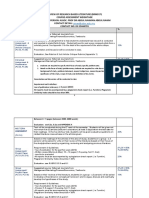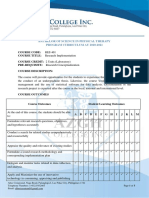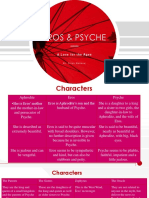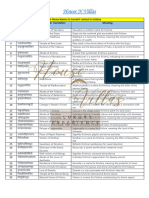Scheme of Work: Universiti Teknologi Mara
Scheme of Work: Universiti Teknologi Mara
Uploaded by
Azrin Kun KidzStudiosCopyright:
Available Formats
Scheme of Work: Universiti Teknologi Mara
Scheme of Work: Universiti Teknologi Mara
Uploaded by
Azrin Kun KidzStudiosOriginal Title
Copyright
Available Formats
Share this document
Did you find this document useful?
Is this content inappropriate?
Copyright:
Available Formats
Scheme of Work: Universiti Teknologi Mara
Scheme of Work: Universiti Teknologi Mara
Uploaded by
Azrin Kun KidzStudiosCopyright:
Available Formats
UHEK_BHEA_2013
UNIVERSITI TEKNOLOGI MARA
SCHEME OF WORK
Course Code : BRM917
Course Name : REVIEW OF RESEARCH BASED LITERATURE
Level : DBA
Total SLT : 160 hours
Part : 1
Course Status : Core
(Core/Non Core)
Prerequisite : None
Nama Ashad Ayub Graduate Business School Tahun Mula: 2018
Nama Program: DBA Tahun Semakan: 2020
© Hak Cipta Universiti Teknologi MARA
UHEK_BHEA_2013
Course Learning Outcomes
At the end of the course, students should be able to:
1– Criticising the relevant past studies on a particular research area. (PLO6, C5)
2 – Organize previous literature based on its strength and weakness to develop
appropriate theoretical framework (PLO8, A4)
3 – Prepare appropriate theoretical or conceptual framework based on the literature
reviewed through group work (PLO5, A4)
Course Description
This course aims to build candidates’ knowledge on the process involved in pursuing
systematic research through the search and review of existing research work. The skills
learn in this course should prepare candidates for the rigor of planning and designing an
appropriate literature review section supported by previous research for their thesis.
Syllabus Content
1. Selection of a Research Area and Topic
1.1 Wide research area
1.2 Funnel down to a do able topic
2. Literature Databases and Search
2.1 Online databases available in the university and outside
2.2 Basic and advance search with keywords
3. Identify the Literature to Review
3.1 General descriptor from the database thesaurus
3.2 Redefine your topic if needed
3.3 Identify landmark or classic studies and theorists in preparation for a
framework
4. Analyse the Literature
4.1 Overview the articles
4.2 Group the articles into categories
4.3 Make notes
5. Summarize the Literature
5.1 Build tables as a key way to help overview, organize, and summarize
5.2 Key terms and concepts, research methods, summary of research results
6. Synthesize the Literature prior to Writing Review
6.1 Develop an outline of Literature Review
6.2 Consideration of the purpose and voice
6.3 Organize findings into a unique analysis
6.4 Create topic outlines that trace research argument
7. Writing the Review
7.1 Identify the broad problem area
7.2 Early in the review, indicate why the topic being reviewed is important
7.3 Distinguish between research finding and other sources of information
7.4 Indicate why certain studies are important
Nama Ashad Ayub Graduate Business School Tahun Mula: 2018
Nama Program: DBA Tahun Semakan: 2020
© Hak Cipta Universiti Teknologi MARA
UHEK_BHEA_2013
7.5 Discuss other literature reviews on your topic
7.6 Avoid long lists of nonspecific references
7.7 When results of previous studies are inconsistent or widely varying, cite them
separately
7.8 Cite all relevant references in the review section of thesis, dissertation, or
journal article
8. Developing a Coherent LR
8.1 Provide an overview near the beginning of the review
8.2 State explicitly what will be covered
8.3 Specify point of view early in the review: this serves as the thesis statement of
the review.
8.4 Aim for a clear and cohesive essay
8.5 Use subheadings, especially in long reviews
8.6 Use transitions to help trace argument
8.7 If the topic teaches across disciplines, consider reviewing studies from each
discipline separately
8.8 Write a conclusion for the end of the review
9. Review APA guidelines
9.1 Familiar with the common core elements of how to write in APA style
Teaching Methodology
Lecture
Discussion
Active Learning
Assessment
Individual Assignments 40%
Group Assignment 40%
Mid Term Assessment (Assignment) 20%
Total 100%
References
Ranjit Kumar (2019), Research Methodology (5th Edition), Thousand Oaks, SAGE
Publications Ltd.
Gall, M. D., Borg, W. R., Gall, J. P. (2003). Educational research: An introduction. (7th
Edition). White Plains, New York: Longman.
Rozakis, L. (1999). Schaum's quick guide to writing great research papers. New York:
McGraw-Hill. (available for free as an e-book via
http://www.library.unh.edu/whatsnew/ebooks.htm)
UiTM Library Research Databses
APA Style Essentials: overview of common core of elements of APA style.
APA Research Style Crib Sheet is a summary of rules for using APA style.
Purdue OWL (Online Writing Lab): A user-friendly writing lab that parallels with the 5th
edition APA manual.
Nama Ashad Ayub Graduate Business School Tahun Mula: 2018
Nama Program: DBA Tahun Semakan: 2020
© Hak Cipta Universiti Teknologi MARA
UHEK_BHEA_2013
Links to Resources on Using Internet Resources and Writing a Literature Review:
http://www.utoronto.ca/writing/litrev.html
http://www.ecu.edu.au/centres/library-services/workshops-and-training/referencing/related-
content/downloads/ECU-Referencing-Guide-2014-July-update.pdf
http://www.deakin.edu.au/library/findout/research/litrev.php
http://www.erin.utoronto.ca/~w3lib/pub/evaluate/webevalu.htm
Nama Ashad Ayub Graduate Business School Tahun Mula: 2018
Nama Program: DBA Tahun Semakan: 2020
© Hak Cipta Universiti Teknologi MARA
UHEK_BHEA_2013
COURSE OUTCOMES – PROGRAM OUTCOMES MATRIX
TEACHING
PROGRAM LEARNING OUTCOMES ASSESSMENT
COURSE LEALRNING METHODOLOGY
OUTCOMES PLO PLO PLO PLO PLO PLO PLO PLO PLO PLO PLO
1 2 3 4 5 6 7 8 9 10 11
a. Criticising the relevant past Lecture, Individual
studies on a particular Discussion, Assignment
research area. (PLO6, C5) Collaborative
Learning
b. Organize previous Lecture, Individual
literature based on its Discussion, Assignment
strength and weakness to Active Learning
develop appropriate
theoretical framework
(PLO8, A4)
c. Prepare appropriate Lecture, Group
theoretical or conceptual Discussion, Assignment
framework based on the Active Learning
literature reviewed through
group work (PLO5, A4)
List of PLO/MQF:
PLO1: Apply knowledge and contribute to original research from interdisciplinary perspectives.
PLO2: Display skills using research tools, techniques or procedure related to relevant area of study.
PLO3: Demonstrate social discourse skills and responsibilities in dynamic business environment.
PLO4: Display good values, attitude and professionalism throughout the research process.
PLO5: Perform good communication, leadership and teamwork skills when engaging in group activities.
PLO6: Provide appropriate solutions in decision making.
PLO7: Integrate appropriate information management and lifelong learning skills.
PLO8: Practice managerial and/or entrepreneurial skills for career advancement
Nama Ashad Ayub Graduate Business School Tahun Mula: 2018
Nama Program: DBA Tahun Semakan: 2020
© Hak Cipta Universiti Teknologi MARA
UHEK_BHEA_2013
Nama Ashad Ayub Graduate Business School Tahun Mula: 2018
Nama Program: DBA Tahun Semakan: 2020
© Hak Cipta Universiti Teknologi MARA
You might also like
- The Idiot - Elif BatumanDocument4 pagesThe Idiot - Elif BatumanSofía Dominguez Olivera33% (3)
- The Cambridge Introduction To The Old Norse-Icelandic Saga PDFDocument226 pagesThe Cambridge Introduction To The Old Norse-Icelandic Saga PDFJakub Hyła100% (3)
- Review of Research Based Literature (Brm917)Document8 pagesReview of Research Based Literature (Brm917)Azrin Kun KidzStudiosNo ratings yet
- 01 - Course Outline - CRW - Online VersionDocument5 pages01 - Course Outline - CRW - Online VersionHoa Tống KiềuNo ratings yet
- Preparation of Language Learning MaterialsDocument4 pagesPreparation of Language Learning Materialsjade100% (3)
- The Hong Kong Polytechnic University Subject Description FormDocument4 pagesThe Hong Kong Polytechnic University Subject Description FormBin ChristianNo ratings yet
- Busines ResearchDocument4 pagesBusines ResearchKaye CeeNo ratings yet
- Disseration Writing and Presentation Course ManualDocument12 pagesDisseration Writing and Presentation Course Manualaditya himatsingkaNo ratings yet
- Ion Mincu Cercetare Programa ENDocument4 pagesIon Mincu Cercetare Programa ENNatasha JacobsNo ratings yet
- Discourse AnalysisDocument4 pagesDiscourse AnalysisAbrar SaroyaNo ratings yet
- 0 Guidelines For Seminar Course Administration 2023 - 1Document10 pages0 Guidelines For Seminar Course Administration 2023 - 1gautam.rojNo ratings yet
- RPS RM in ELT - Iroh 17 January 2022Document20 pagesRPS RM in ELT - Iroh 17 January 2022Alamsyah Dafio100% (1)
- Thesis GuideDocument48 pagesThesis Guiderdwamena86No ratings yet
- ΝΑ52 Business-StrategiesDocument4 pagesΝΑ52 Business-Strategieslaura.muhvicNo ratings yet
- PHD Dissertation ENG 990 Course SpecificationsDocument13 pagesPHD Dissertation ENG 990 Course Specificationsوائل الصاويNo ratings yet
- Methods of Research Learning Plan New FormatDocument9 pagesMethods of Research Learning Plan New FormatAlma Mae BernalesNo ratings yet
- RESEARCH 1 SyllabusDocument8 pagesRESEARCH 1 SyllabusroniloNo ratings yet
- Course Pack of Data WarehouseDocument17 pagesCourse Pack of Data WarehouseAjit KumarNo ratings yet
- PCOM Manual End TermDocument17 pagesPCOM Manual End Termkytld21No ratings yet
- Bachelor of Science in Physical Therapy Program Curriculum Ay 2020-2021Document5 pagesBachelor of Science in Physical Therapy Program Curriculum Ay 2020-2021beaNo ratings yet
- Module DescriptorDocument3 pagesModule Descriptorkarthiknataraj16No ratings yet
- Sylabus Aca WritingDocument2 pagesSylabus Aca WritingNovi FitriyaniNo ratings yet
- LG240 - ALS630 - Course InformationDocument4 pagesLG240 - ALS630 - Course InformationNurul NadiahNo ratings yet
- Research Report - 031810Document7 pagesResearch Report - 031810Wawa ManNo ratings yet
- Guidelines PreproposalDocument1 pageGuidelines Preproposalowais_36No ratings yet
- M506 - Assessment-brief-Oct 2023 (2) - 231213 - 184903Document9 pagesM506 - Assessment-brief-Oct 2023 (2) - 231213 - 184903Boy In The BoxNo ratings yet
- AcademicWriting ModuleHandbookDocument19 pagesAcademicWriting ModuleHandbookΠαουλα ΕλμαζαιNo ratings yet
- Guidelines and Format in The Development of Instructional MaterialsDocument8 pagesGuidelines and Format in The Development of Instructional MaterialsJevelyn Lagumbay AntecamaraNo ratings yet
- Dissertation MBAO Vfinal-1Document7 pagesDissertation MBAO Vfinal-1Hajar DriouchNo ratings yet
- GSOE9011 Course Outline 2022, T3, V1Document14 pagesGSOE9011 Course Outline 2022, T3, V1kevinprq7No ratings yet
- BBA-VI - Business Research Methods Outline - Fall 2019Document4 pagesBBA-VI - Business Research Methods Outline - Fall 2019Rahul DusejaNo ratings yet
- Reporting and Sharing FindingsDocument10 pagesReporting and Sharing Findingsapi-339611548100% (5)
- Project Guidelines RD 1578001414Document11 pagesProject Guidelines RD 1578001414virat kolhiNo ratings yet
- Accounting Research MethodsDocument7 pagesAccounting Research Methodsjaspermallari1995No ratings yet
- Module 5Document3 pagesModule 5floramae.malabagoNo ratings yet
- Theory of DatabasesDocument9 pagesTheory of Databasesherbertjohn24No ratings yet
- Arc6990 2022 23 Module HandbookDocument20 pagesArc6990 2022 23 Module Handbookyrotsih.lishiNo ratings yet
- Math 131 - Action Research in Mathematics EducationDocument9 pagesMath 131 - Action Research in Mathematics EducationAngel Guillermo Jr.No ratings yet
- Math 131 - Action Research in Mathematics EducationDocument9 pagesMath 131 - Action Research in Mathematics EducationAngel Guillermo Jr.No ratings yet
- 5e.2023 Nghe Thuat Lanh DaoDocument7 pages5e.2023 Nghe Thuat Lanh DaohuynhthimaidiuNo ratings yet
- Unit 1. Lesson 2Document5 pagesUnit 1. Lesson 2Anna TarasovaNo ratings yet
- Research ReportDocument11 pagesResearch ReportPrathama ShindeNo ratings yet
- MBR2060T - RM - Lesson PlanDocument6 pagesMBR2060T - RM - Lesson PlanAnwesha KarmakarNo ratings yet
- BUAD 819 Note-Management & OrganisationalDocument170 pagesBUAD 819 Note-Management & Organisationalhead of State NigeriaNo ratings yet
- Elc550 Course Info (250219)Document4 pagesElc550 Course Info (250219)miorsocceroosNo ratings yet
- C - 403 Project Report Study - Syllabus 2021-23Document14 pagesC - 403 Project Report Study - Syllabus 2021-23sachi priyaNo ratings yet
- PRACRES1 SyllabusDocument9 pagesPRACRES1 SyllabusJoshua ApolonioNo ratings yet
- Research 101B Research Methods in Business Administration 1Document11 pagesResearch 101B Research Methods in Business Administration 1KAREN SALVE MAUTENo ratings yet
- Lecture 6 - Reporting and Sharing FindingsDocument18 pagesLecture 6 - Reporting and Sharing FindingssevynNo ratings yet
- Foun 1106 Course Outline Semester 1 2017 - 2018Document13 pagesFoun 1106 Course Outline Semester 1 2017 - 2018Kini Bubblezz HaynesNo ratings yet
- A2 Analysing Physical ProcessesDocument3 pagesA2 Analysing Physical ProcessesRiaz BhuiyaNo ratings yet
- Academic Writing OutlineDocument40 pagesAcademic Writing Outlinecol akhtarNo ratings yet
- Research Methodology SyllabusDocument4 pagesResearch Methodology SyllabusatikaNo ratings yet
- Accountancy ResearchDocument6 pagesAccountancy ResearchMohammad MacaumbosNo ratings yet
- A Systematic Literature Review On Teaching and Learning Introductory Programming in Higher EducationDocument14 pagesA Systematic Literature Review On Teaching and Learning Introductory Programming in Higher Educationmedeiros_rodNo ratings yet
- Module 4 ManualDocument17 pagesModule 4 ManualGersonNo ratings yet
- Obe Syllabus in Politics and Governance With Philippine ConstitutionDocument8 pagesObe Syllabus in Politics and Governance With Philippine ConstitutionId Sun100% (1)
- CohortDocument11 pagesCohortPaul AsturbiarisNo ratings yet
- Dev Reading 1-SyllabusDocument2 pagesDev Reading 1-SyllabusMearie Jean Amba FaustinoNo ratings yet
- Clo TemplateDocument5 pagesClo Templatesaira tahirNo ratings yet
- Curriculum MappingDocument14 pagesCurriculum MappingpradeljnndaisyNo ratings yet
- ChatGPT: GUIDE TO WRITE A SCIENTIFIC RESEARCH PAPER FOR ENGINEERS, RESEARCHERS, AND SCIENTISTSFrom EverandChatGPT: GUIDE TO WRITE A SCIENTIFIC RESEARCH PAPER FOR ENGINEERS, RESEARCHERS, AND SCIENTISTSNo ratings yet
- Academic Presenting and Presentations: Teacher's BookFrom EverandAcademic Presenting and Presentations: Teacher's BookRating: 5 out of 5 stars5/5 (1)
- The Effect of Brand Authenticity On Consumer-Brand RelationshipsDocument11 pagesThe Effect of Brand Authenticity On Consumer-Brand RelationshipsAzrin Kun KidzStudiosNo ratings yet
- Review of Research Based Literature (Brm917) Course Assessment Weightage Resource Person: Assoc. Prof DR Abdul Rahman Abdul Rahim Contact DetailDocument1 pageReview of Research Based Literature (Brm917) Course Assessment Weightage Resource Person: Assoc. Prof DR Abdul Rahman Abdul Rahim Contact DetailAzrin Kun KidzStudiosNo ratings yet
- Article CritikDocument8 pagesArticle CritikAzrin Kun KidzStudiosNo ratings yet
- Profit ChainDocument19 pagesProfit ChainAzrin Kun KidzStudiosNo ratings yet
- Consumer - Green Brand Relationships: Revisiting Bene Fits, Relationship Quality and OutcomesDocument22 pagesConsumer - Green Brand Relationships: Revisiting Bene Fits, Relationship Quality and OutcomesAzrin Kun KidzStudiosNo ratings yet
- Trott - Innovation Management OverviewDocument18 pagesTrott - Innovation Management OverviewAzrin Kun KidzStudiosNo ratings yet
- 1 - APERC Executive SummaryDocument6 pages1 - APERC Executive SummaryAzrin Kun KidzStudiosNo ratings yet
- Logistik Kembara TBKDocument1 pageLogistik Kembara TBKAzrin Kun KidzStudiosNo ratings yet
- Basic MATLAB Programming CourseDocument146 pagesBasic MATLAB Programming CourseAzrin Kun KidzStudiosNo ratings yet
- AdvertisementDocument1 pageAdvertisementAzrin Kun KidzStudiosNo ratings yet
- BOOK REVIEW: Harry Potter and The Chamber of SecretsDocument15 pagesBOOK REVIEW: Harry Potter and The Chamber of SecretsMaryRoseL.Samson100% (1)
- Othello Essay PolishedDocument3 pagesOthello Essay Polishedemmasydney314No ratings yet
- Inbound 1052497755233107700Document14 pagesInbound 1052497755233107700rodriguezdarwin239No ratings yet
- The Heart Stomach and Backbone of Pakistan Lahore in Novels by Bapsi Sidhwa and Mohsin HamidDocument20 pagesThe Heart Stomach and Backbone of Pakistan Lahore in Novels by Bapsi Sidhwa and Mohsin HamidHayacinth EvansNo ratings yet
- Developmental Reading TopicsDocument4 pagesDevelopmental Reading TopicsFlorence Ivy MagtanongNo ratings yet
- English Literature Project (1st Term)Document14 pagesEnglish Literature Project (1st Term)ashlesha thopteNo ratings yet
- Eros PsycheDocument13 pagesEros Psycheapi-497543601No ratings yet
- Beauty and The BeastDocument4 pagesBeauty and The BeastJssy MayNo ratings yet
- Hamlet and His Problems: ContentDocument14 pagesHamlet and His Problems: ContentDhanush N100% (2)
- House Names in Sanskrit Related To KrishnaDocument2 pagesHouse Names in Sanskrit Related To Krishnapranavpanchal1000No ratings yet
- Dawam by Ahmed Nadeem Qasmi Poetry BookDocument116 pagesDawam by Ahmed Nadeem Qasmi Poetry BookmaisramehmoodNo ratings yet
- Literatute in CaragaDocument2 pagesLiteratute in CaragaAruyal Deocampo AnngelaNo ratings yet
- Diagnostic Pretest TOEFL ITP - Taken From Longman TOEFLDocument25 pagesDiagnostic Pretest TOEFL ITP - Taken From Longman TOEFLPriandi Imaduddin Sudarma100% (1)
- WEEK 3-4 FINALSDocument35 pagesWEEK 3-4 FINALSRaijah PasasadabaNo ratings yet
- G. K. Chesterton - WikipediaDocument30 pagesG. K. Chesterton - WikipediaGowshikraja GowshikrajaNo ratings yet
- The Poem Is The Real A Poetics by Gemino H. Abad 2Document6 pagesThe Poem Is The Real A Poetics by Gemino H. Abad 2Kyla Marie Adlawan100% (1)
- Hayavadana Related Studies 3Document3 pagesHayavadana Related Studies 3Priyadharshini sRNo ratings yet
- 5 Planificare 24Document6 pages5 Planificare 24galanmihaellaNo ratings yet
- Unfurl 2 Stuart BARNESDocument16 pagesUnfurl 2 Stuart BARNESStephen J. WilliamsNo ratings yet
- Complete This After Reading Chilblains and Semolina PuddingDocument9 pagesComplete This After Reading Chilblains and Semolina Puddingapi-237280457No ratings yet
- Practical Research 2: Quarter 1 - Module 2Document46 pagesPractical Research 2: Quarter 1 - Module 2Kristopher MartinNo ratings yet
- Dissertation IejDocument5 pagesDissertation IejHelpWritingAPaperForCollegeUK100% (1)
- Aristotle - William Lambert Newman (Ed.) - The Politics of Aristotle, Volume II - Prefatory Essays. Books I and II (1887, Clarendon Press)Document494 pagesAristotle - William Lambert Newman (Ed.) - The Politics of Aristotle, Volume II - Prefatory Essays. Books I and II (1887, Clarendon Press)Gabriel Viana SilveiraNo ratings yet
- The Idea of The Renaissance, Revisited: Brian Vickers University of ZurichDocument27 pagesThe Idea of The Renaissance, Revisited: Brian Vickers University of ZurichWasima TabassumNo ratings yet
- BTS ( ) - Permission To DanceDocument7 pagesBTS ( ) - Permission To Dancehhm060220No ratings yet
- Japanese Literature - Donald KeeneDocument38 pagesJapanese Literature - Donald Keenepaco mrNo ratings yet
- Earliest Vinayā - by Frauwallner - in Chrono OrderDocument110 pagesEarliest Vinayā - by Frauwallner - in Chrono OrderSunitha KrishnanNo ratings yet
- Toh9 84000 The Perfection of Wisdom in Twenty Five Thousand LinesDocument1,911 pagesToh9 84000 The Perfection of Wisdom in Twenty Five Thousand Linesfrans.indrata2No ratings yet




































































































